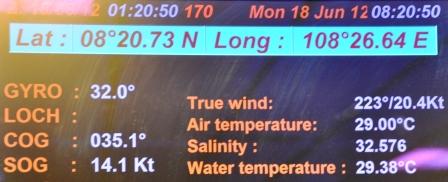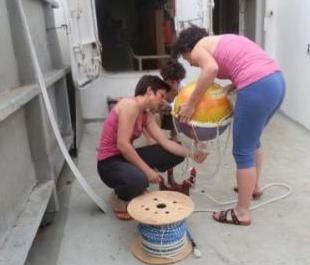In the next two weeks, GeoLog has the pleasure to host reports from Teachers at Sea. This educational programme, co-sponsored by the European Geosciences Union (EGU) and the French Polar Insitute (IPEV), gives school teachers the opportunity to take part in oceanographic cruises with scientists. This year, Sandrine Vivier and Ana Sánchez, teachers of Biology and Geology in Rodez (France) and Madrid (Spain), respectively, together with EGU’s Education Chair Carlo Laj, join scientists on board of the Marion Dufresne. The research vessel is navigating the South China Sea where teachers will work alongside scientists in collecting marine sediments to retrieve the secrets of deep ocean circulation and understand past variations of the Asian Monsoon. Check out the first post of this series here.
Report 2: The scientific adventure begins
Hello everyone!
This morning [18/06] we had our first meeting with Catherine Kissel and Zhimin Jian, the two chief scientists, who outlined the main scientific objectives of the CIRCEA (CIRCulation East Asian regions) mission, and also told us about the difficulties encountered during the preparation of this cruise.
We then listened to a technical introduction to the different coring systems available on the Marion Dufresne (the Calypso and Casq corers) by Yvan Réeaud of the French Polar Institute (IPEV).
In the afternoon, the Malaysian team from the University Sains Malaysia in Penang, presented some of their research programmes. First, Nithiyaa Nilamani, a PhD student, introduced us to the topic of ocean acidification, describing some of her first results and giving an overview on the impact of the decrease in pH in the ocean on calcareous organisms such as coral reefs. Then Foong Swee Yeok, a lecturer at the University, gave an overview of the situation of mangrove trees in Malaysia, with emphasis on the massive destruction of this habitat due to the 2004 tsunami, but also as a result of human activities.
On board, people are getting their instruments ready for operating at the first site, which we will reach in two days. On the deck in the back of the Marion, Yvan tested the triggering mechanism for the Calipso corer, which is our main coring instrument; in front Sandrine tested a buoy built by her pupils in France, in the framework of an educational program sponsored by the French Space Agency (CNES). If all goes as planned, the buoy will be dropped into the South China Sea, will wander around pushed by surface currents, and transmit data on the temperature of the water and movement of waves, as well as the approximate state of the sea. Students and teachers in France will receive this information via satellite. Today Sandrine tested the batteries inside the buoy and so far so good. We’ll keep you posted on the progress of this project.
We have also started a movie on the life on board, which we hope to be able to show at the 2013 GIFT Workshop in Vienna.
Keep checking this space for more updates on the life and work on board the Marion Dufresne!
By Sandrine Vivier, Ana Sánchez, and Carlo Laj




